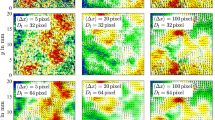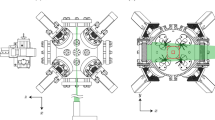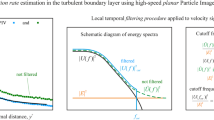Abstract
Phase-Doppler anemometry (PDA) is a powerful tool for two-phase flow measurements and testing. Particle concentration and mass flux can also be evaluated using the raw particle data supplied by this technique. The calculation starts from each particle velocity, diameter, transit time data, and the total measurement time. There are two main evaluation strategies. The first one uses the probe volume effective cross section, and it is usually simplified assuming that particles follow quasi one-directional trajectories. In the text, it will be called the cross section method. The second one includes a set of methods which will be denoted as “Generalized Integral Methods” (GIM). Concentration algorithms such as the transit time method (TTM) and the integral volume method (IVM) are particular cases of the GIM. In any case, a previous calibration of the measurement volume geometry is necessary to apply the referred concentration evaluation methods. In this study, concentrations and mass fluxes both evaluated by the cross-section method and the TTM are compared. Experimental data are obtained from a particle-laden jet generated by a convergent nozzle. Errors due to trajectory dispersion, burst splitting, and multi-particle signals are discussed.
























Similar content being viewed by others
Abbreviations
- A :
-
Effective probe volume cross section
- C :
-
Concentration
- D :
-
Particle diameter
- If :
-
Integral parameter
- K :
-
Electro-optical gain of the PDA system
- d 0 :
-
Nominal laser beam diameter
- d X , d Y , d Z :
-
Probe volume axes
- d T :
-
Effective probe volume diameter
- f :
-
Arbitrary function
- F, F :
-
Flux (vector and modulus)
- K LAmp, V Ref :
-
Parameters of the PDA logarithmic amplifier
- L S :
-
Width of the optical spatial filter projected on the probe volume
- L Z :
-
Effective length of the probe volume (measured along the optical axis of the PDA emitter)
- N :
-
Number of particles
- n :
-
Unitary vector tangent to the particle trajectory
- r :
-
Radial coordinate
- r 0 :
-
Nominal laser beam radius
- S :
-
Length of the particle trajectory inside the probe volume
- s :
-
Coordinate defined parallel to the particle trajectory
- tt :
-
Particle transit time (residence time inside the probe volume)
- U :
-
Mean particle velocity
- u :
-
Particle velocity modulus
- V(t):
-
Doppler signal base line (as a voltage)
- Vol :
-
PDA probe volume
- V T :
-
Trigger level for the particle signal
- x, y, z :
-
Spatial coordinates
- Δt :
-
Total measurement time
- θ, ψ :
-
Directional angles for n
- i, j, k, l :
-
Indexes of the ith particle size class, jth particle movement direction class, kth particle velocity modulus class. l is the lth particle of the class (i, j, k)
- N :
-
To denote the number particle concentration or number particle flux
- V :
-
To denote the volume concentration or volume flux
- 1D:
-
To denote it is calculated by the cross-section approximation
- TTM:
-
To denote it is calculated by the transit time method
References
Aerometrics (1997) Real-time signal analyzer system manual. Sunnyvale, CA
Aísa L, García JA, Cerecedo LM, García Palacín I, Calvo E (2002) Particle concentration and local mass flow measurements in two-phase flows with PDA. Application to a study on the dispersion of spherical particles in a turbulent air jet. Int J Mult Flow (28):301–324
Albretch HE, Borys M, Damaschke N, Tropea C (2003) Laser Doppler and phase Doppler measurement techniques. Springer-Verlag, Berlin
Araneo L, Damaschke N, Tropea C (2000) Measurement and prediction of the Gaussian beam effect in the phase Doppler technique. In: 10th international symposium on applications of laser techniques to fluid mechanics, Lisbon, Portugal
Bachalo WD, Rudoff RC, Brena de la Rosa A (1988) Mass flux measurements of a high number density spray system using the phase Doppler particle analyzer. In: AIAA 26th aerospace science meeting, 11–14 Jan, Reno, Nevada. EEUU
Calvo E (2005) Estudio experimental de estructura, dispersión y mezcla en un chorro gas-partículas con control por forzado. PhD Thesis, Universidad de Zaragoza, Zaragoza, Spain (in Spanish)
Calvo E, García JA, Cerecedo LM, García-Palacín I, Aísa L (2000) Particle concentration and mass flux measurements with PDA: a study about methods and errors. In: Proceedings of 16th European conference on liquid atomization and spray systems (ILASS), Darmstadt, Germany, pp V.10.1–V.10.6
García JA (2000) Estudio experimental de un chorro bifásico axilsimétrico: medidas de concentración e intensidad de flujo de partículas; características de dispersión. PhD Thesis, Universidad de Zaragoza, Zaragoza, Spain (in Spanish)
Lázaro BJ (1991) Evaluation of phase Doppler particle sizing in the measurement of optically thick, high number density sprays. UTRC91-11. United Technologies Research Center, East Hartford, CT. EEUU
Qiu HH, Sommerfeld M (1992) A reliable method for determining the measurement volume size and particle mass fluxes using phase-Doppler anemometry. Exp Fluids 13:293–404
Roisman IV, Tropea C (2000) Drops distributions measurement en sprays using the phase Doppler technique. In: 10th international symposium on applications of laser techniques to fluid mechanics, Lisbon, Portugal
Roisman IV, Tropea C (2001) Flux measurements in sprays using phase Doppler techniques. At Sprays 11(6):667–699
Saffman M (1987) Automatic calibration of LDA measurement volume size. Appl Opt 26(13):2592–2597
Saffman M, Buchhave H, Tanger H (1984) Simultaneous measurement of size in phase Doppler interferometry: minimizing and eliminating sizing error. In: Proceedings of the 6th international symposium on applications of laser techniques to fluid mechanics, Lisbon, Portugal, paper 8.1
Sankar SV, Inenaga AS, Bachalo WD (1992) Trajectory dependent scattering in phase Doppler interferometry: minimizing and eliminating sizing errors. In: Proceedings of the 6th international symposium on applications of laser techniques to fluid mechanics, Lisbon, Portugal
Sommerfeld M, Qiu HH (1995) Particle concentration measurements by phase-doppler anemometry in complex dispersed two-phase flows. Exp Fluids 18:187–198
Van den Moortel T, Santini R, Tadrist L, Pantaloni J (1997) Experimental study of the particle flow in a circulating fluidized bed using a phase Doppler particle analyser: a new post-processing data algorithm. Int J Mult Flow 263(6):1189–1209
Author information
Authors and Affiliations
Corresponding author
Rights and permissions
About this article
Cite this article
Calvo, E., García, J.A., García, I. et al. Errors analysis in the evaluation of particle concentration by PDA on a turbulent two-phase jet: application for cross section and transit time methods. Exp Fluids 47, 489–508 (2009). https://doi.org/10.1007/s00348-009-0678-6
Received:
Revised:
Accepted:
Published:
Issue Date:
DOI: https://doi.org/10.1007/s00348-009-0678-6




